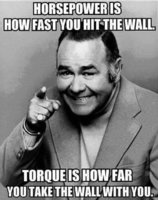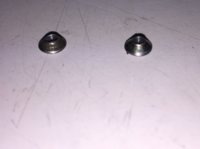So I had the opportunity to sneak out to the garage for a few hours and see if I could make some progress on breaking down my carburetors.
This morning I ran to Harbor Freight and picked up a few things, a set of Torx head bits, ( I could not find any bolt extractors nearly small enough ) a hole punch set so I can make my own gaskets and something I’ve wanted for a long time, an ultrasonic parts cleaner. They had 25% off today.....woo hoo! So I’m going to try the Pine-Sol ultrasonic treatment, and I’m gonna crank that baby up! I also intend on spraying out all the passageways Berryman B-12 Chemtool. I want these baby’s to shine!
Back to my carburetors......I got my new Torx bits out and grabbed the smallest tip, and Crap! Still too big to fit inside my drilled my drilled out butterfly screws. I tried a few other things to try and back those screws out but no luck. So....I got my drill out and went one size larger than my drilled out hole and drilled it again. This time I had complete success! The drill bit caught and spun those screws right out and didn’t leave a mark on the threads!
Then I broke out my other carburetor that has been soaking in penetrating oil for the last 24 hours, and.... long story short, I stripped the heads out of those too. They wouldn’t budge. “ That’s OK “ I said , brimming with new found confidence, “I’ll drill those puppies right out!”
Well, I did....but not without some damage this time. When the drill bit caught the screw and spun it, it kinda flattened, smoothed the threads on both holes. I can still screw a new screw into it but I don’t have a lot of confidence in the integrity of the threads.
So what is the solution here? Should I just locktite it and hope for the best? Is this butterfly shaft from my XS2 BS38 interchangeable with later models? Or , I probably have room to put a thin nut on the backside that could also be locktited, would you trust that? I would LOVE. some input on these questions. Thanks in advance!
Now on to another issue that I swear I would not have even thought of.
Is my butterfly shaft true? I’ll be darned if 2M didn’t call it. The first shaft was binding slightly in operation before I pulled it out. After removing it, I rolled it across a flat surface, and to my eye I couldn’t really tell anything. Then I held it against a steel ruler and I could see the smallest of gaps in places. But here was the real show, I chucked it in my drill ( Jim’s idea ) and when I turned it on you could see the end bobbing up and down. I held my ruler next to the end and it was moving up and down approximately 1mm.

I was remembering what 2M said that the solid parts of the shaft would most likely be straight, with the bends near the butterfly slot. So I left the butterfly screwed into the slot for support and placed the whole assembly on top of a couple blocks of wood, and just using pressure from my hand I pressed down to straighten the shaft. It didn’t take much, just a couple of tries , double checking by putting it back in the drill and in no time the shaft was dead straight.
I put the whole assembly back in the carburetor and checked the action and the hang up was gone. It works smooth and seals cleanly against the throttle bore. Success! The other shaft had no such wiggle, but that is the one I messed up!

Go figure!
Two other items, I went to remove the butterfly shaft seals and one looks like a regular old shaft seal , but the one that was under that metal cap....is that seal different? Does that seal have a metal band around it? I didn’t want to start prying on it until I was sure.
And lastly, I was curious about these plastic elbows, I can’t seem to find any replacements for them. What do people do with broken ones. They look brittle, and also some of the brass nipples have come loose from the carb bodies. Any tricks on re installing them?
I’ve asked a lot of questions so I’m going to sum up here.
1. How can I resolve the issue with the weak threads on my butterfly shafts?
2. What’s the deal with the seal under the metal caps, is it different from a regular shaft seal.
3. Are those plastic elbows replaceable? Removable?
4. What’s the best way to cement the brass nipples back into the carb body?
I’m gonna try digging up some answers in the archives, but any help appreciated.
Thanks guys!
Bob









 Go figure!
Go figure!